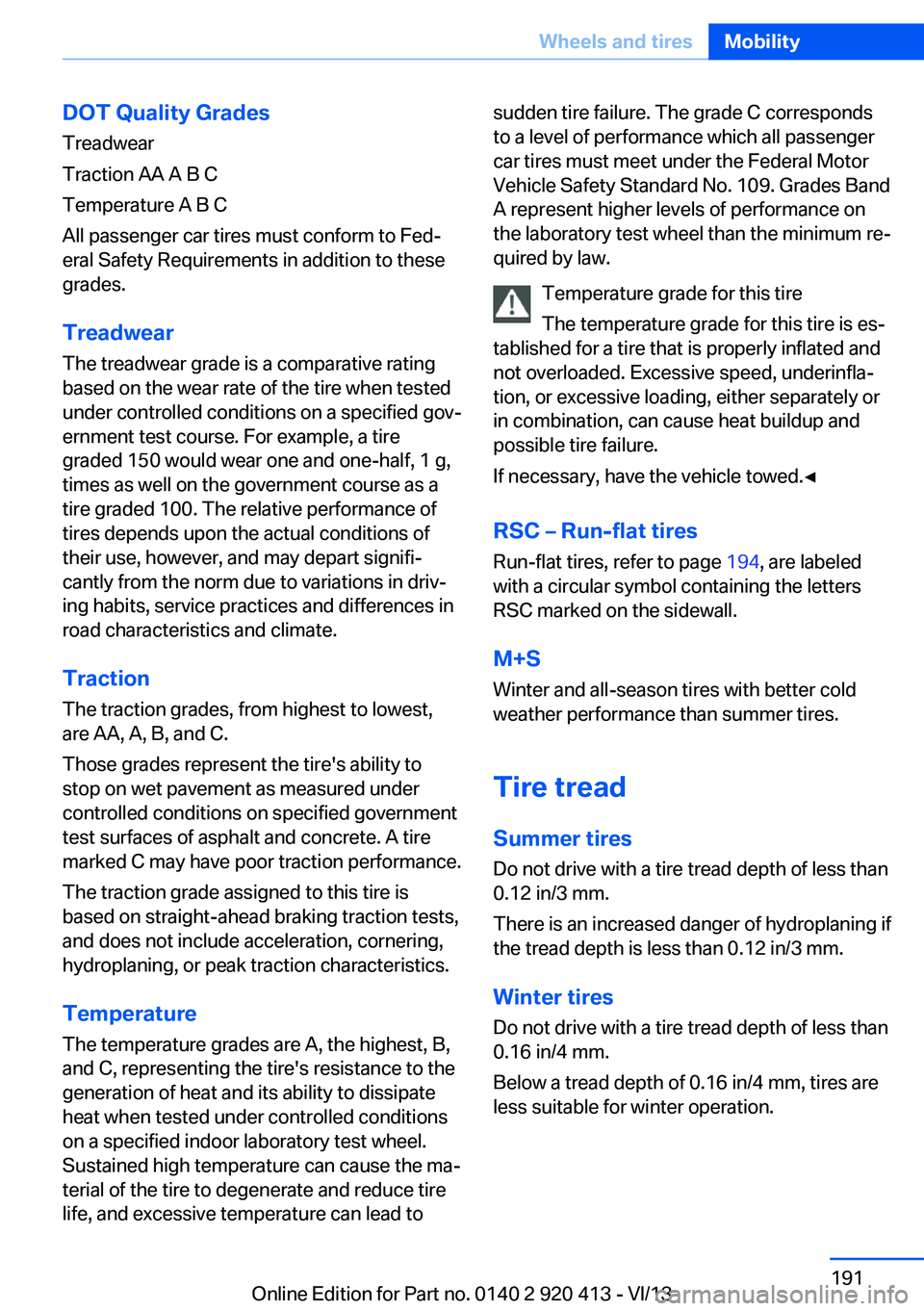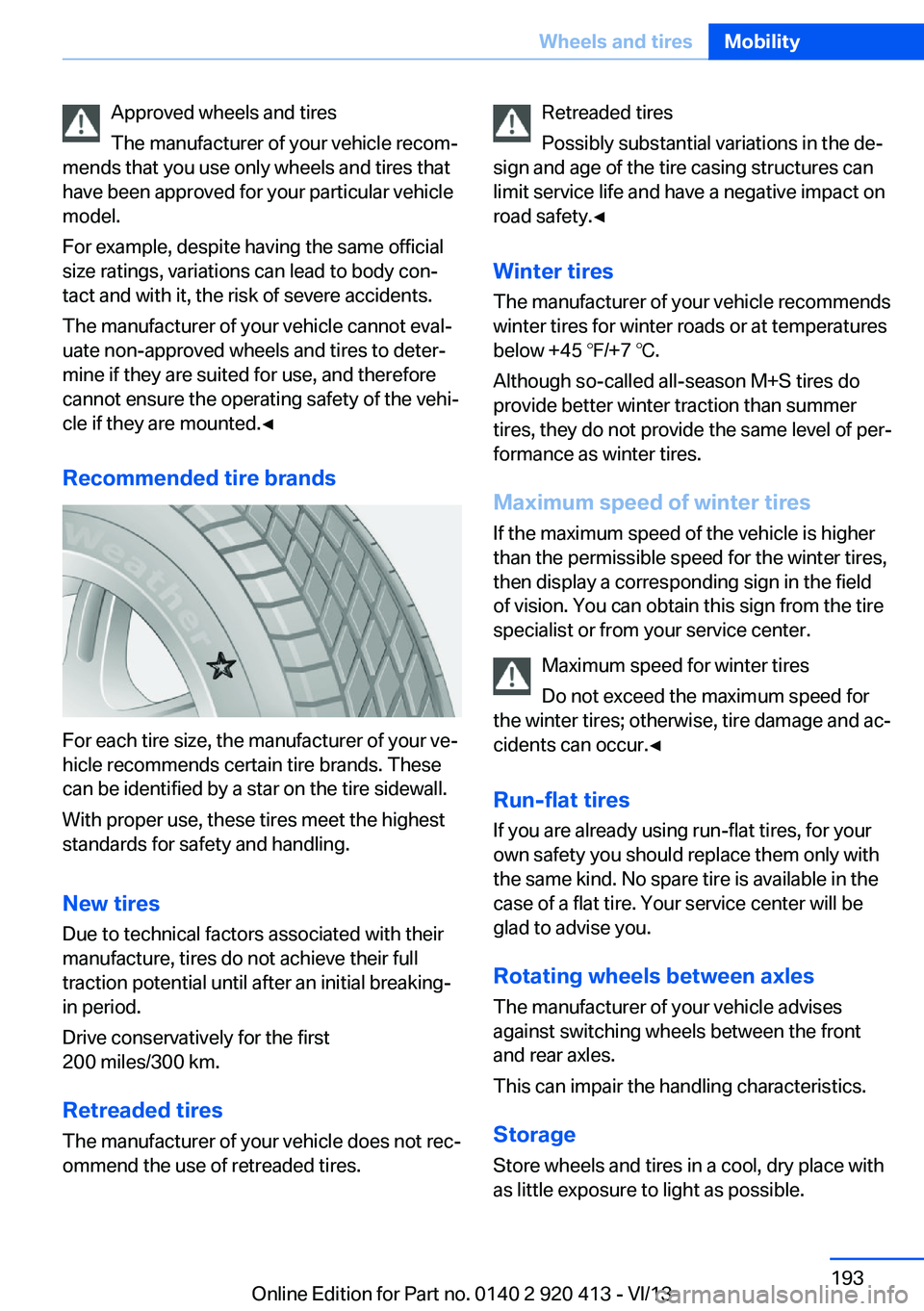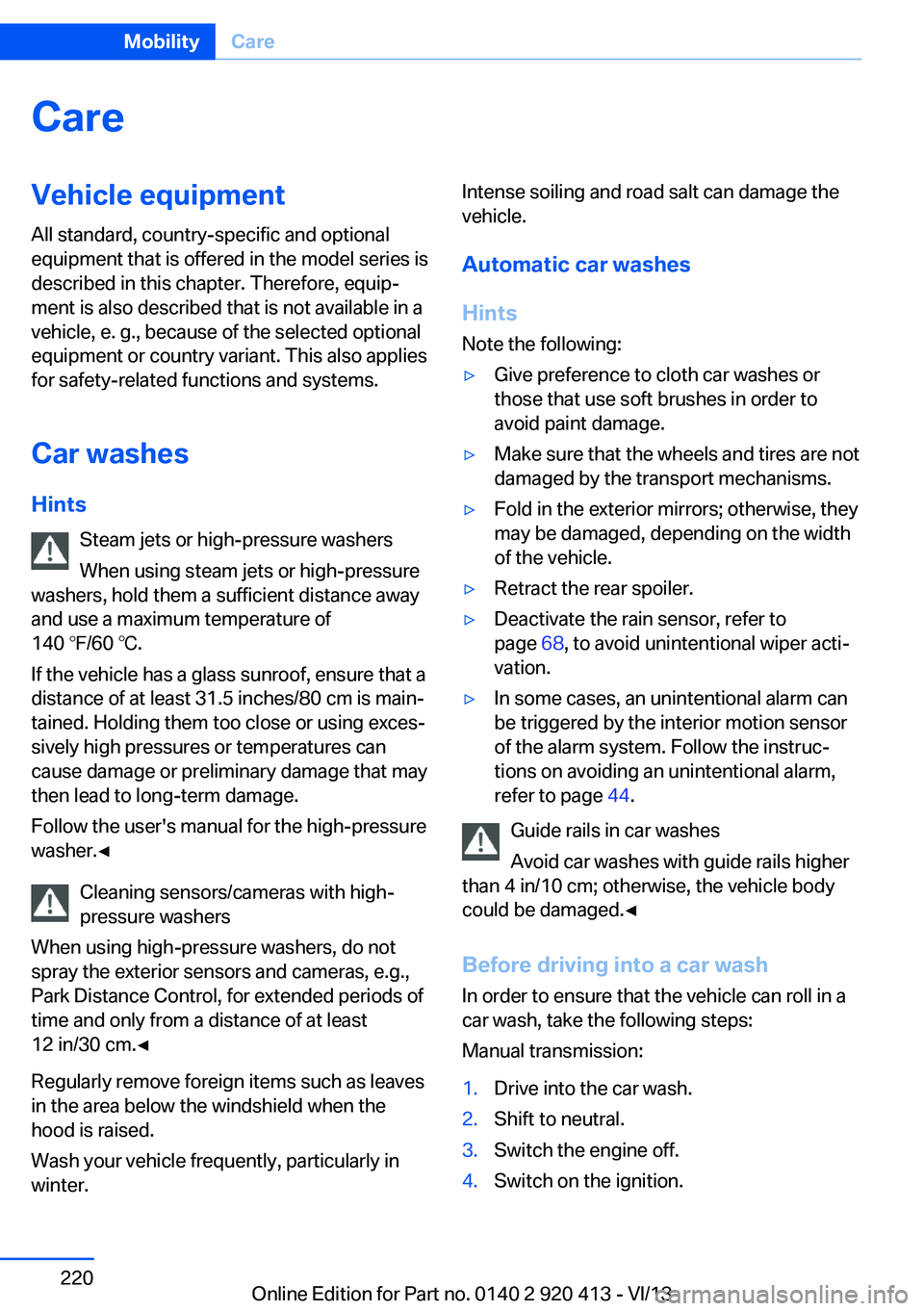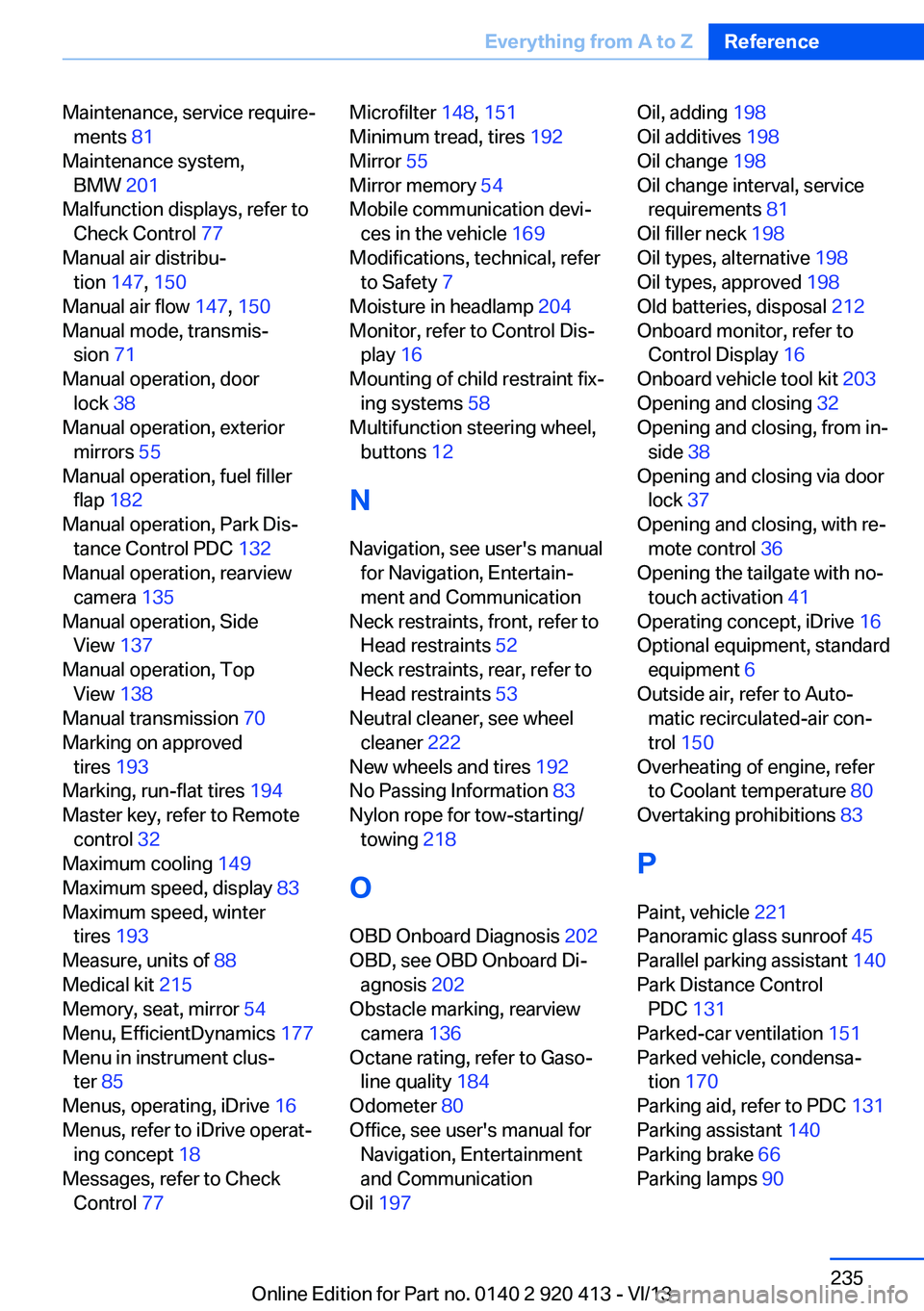2014 BMW 335I XDRIVE GRAN TURISMO winter tires
[x] Cancel search: winter tiresPage 191 of 240

DOT Quality GradesTreadwear
Traction AA A B C
Temperature A B C
All passenger car tires must conform to Fed‐
eral Safety Requirements in addition to these
grades.
Treadwear The treadwear grade is a comparative rating
based on the wear rate of the tire when tested
under controlled conditions on a specified gov‐
ernment test course. For example, a tire
graded 150 would wear one and one-half, 1 g,
times as well on the government course as a
tire graded 100. The relative performance of
tires depends upon the actual conditions of
their use, however, and may depart signifi‐
cantly from the norm due to variations in driv‐
ing habits, service practices and differences in
road characteristics and climate.
Traction
The traction grades, from highest to lowest,
are AA, A, B, and C.
Those grades represent the tire's ability to
stop on wet pavement as measured under
controlled conditions on specified government
test surfaces of asphalt and concrete. A tire
marked C may have poor traction performance.
The traction grade assigned to this tire is
based on straight-ahead braking traction tests,
and does not include acceleration, cornering,
hydroplaning, or peak traction characteristics.
Temperature The temperature grades are A, the highest, B,
and C, representing the tire's resistance to the
generation of heat and its ability to dissipate
heat when tested under controlled conditions
on a specified indoor laboratory test wheel.
Sustained high temperature can cause the ma‐
terial of the tire to degenerate and reduce tire
life, and excessive temperature can lead tosudden tire failure. The grade C corresponds
to a level of performance which all passenger
car tires must meet under the Federal Motor
Vehicle Safety Standard No. 109. Grades Band
A represent higher levels of performance on
the laboratory test wheel than the minimum re‐
quired by law.
Temperature grade for this tire
The temperature grade for this tire is es‐
tablished for a tire that is properly inflated and
not overloaded. Excessive speed, underinfla‐
tion, or excessive loading, either separately or
in combination, can cause heat buildup and
possible tire failure.
If necessary, have the vehicle towed.◀
RSC – Run-flat tires Run-flat tires, refer to page 194, are labeled
with a circular symbol containing the letters
RSC marked on the sidewall.
M+S
Winter and all-season tires with better cold
weather performance than summer tires.
Tire tread
Summer tires
Do not drive with a tire tread depth of less than
0.12 in/3 mm.
There is an increased danger of hydroplaning if
the tread depth is less than 0.12 in/3 mm.
Winter tires
Do not drive with a tire tread depth of less than
0.16 in/4 mm.
Below a tread depth of 0.16 in/4 mm, tires are
less suitable for winter operation.Seite 191Wheels and tiresMobility191
Online Edition for Part no. 0140 2 920 413 - VI/13
Page 193 of 240

Approved wheels and tires
The manufacturer of your vehicle recom‐
mends that you use only wheels and tires that
have been approved for your particular vehicle
model.
For example, despite having the same official
size ratings, variations can lead to body con‐
tact and with it, the risk of severe accidents.
The manufacturer of your vehicle cannot eval‐
uate non-approved wheels and tires to deter‐
mine if they are suited for use, and therefore
cannot ensure the operating safety of the vehi‐
cle if they are mounted.◀
Recommended tire brands
For each tire size, the manufacturer of your ve‐
hicle recommends certain tire brands. These
can be identified by a star on the tire sidewall.
With proper use, these tires meet the highest
standards for safety and handling.
New tires Due to technical factors associated with their
manufacture, tires do not achieve their full
traction potential until after an initial breaking-
in period.
Drive conservatively for the first
200 miles/300 km.
Retreaded tires
The manufacturer of your vehicle does not rec‐
ommend the use of retreaded tires.
Retreaded tires
Possibly substantial variations in the de‐
sign and age of the tire casing structures can
limit service life and have a negative impact on
road safety.◀
Winter tires
The manufacturer of your vehicle recommends
winter tires for winter roads or at temperatures
below +45 ℉/+7 ℃.
Although so-called all-season M+S tires do
provide better winter traction than summer tires, they do not provide the same level of per‐
formance as winter tires.
Maximum speed of winter tires If the maximum speed of the vehicle is higher
than the permissible speed for the winter tires,
then display a corresponding sign in the field
of vision. You can obtain this sign from the tire
specialist or from your service center.
Maximum speed for winter tires
Do not exceed the maximum speed for
the winter tires; otherwise, tire damage and ac‐
cidents can occur.◀
Run-flat tires If you are already using run-flat tires, for your
own safety you should replace them only with
the same kind. No spare tire is available in the
case of a flat tire. Your service center will be
glad to advise you.
Rotating wheels between axles
The manufacturer of your vehicle advises
against switching wheels between the front
and rear axles.
This can impair the handling characteristics.
StorageStore wheels and tires in a cool, dry place with
as little exposure to light as possible.Seite 193Wheels and tiresMobility193
Online Edition for Part no. 0140 2 920 413 - VI/13
Page 220 of 240

CareVehicle equipmentAll standard, country-specific and optional
equipment that is offered in the model series is
described in this chapter. Therefore, equip‐
ment is also described that is not available in a
vehicle, e. g., because of the selected optional
equipment or country variant. This also applies
for safety-related functions and systems.
Car washes Hints Steam jets or high-pressure washers
When using steam jets or high-pressure
washers, hold them a sufficient distance away and use a maximum temperature of
140 ℉/60 ℃.
If the vehicle has a glass sunroof, ensure that a distance of at least 31.5 inches/80 cm is main‐
tained. Holding them too close or using exces‐
sively high pressures or temperatures can
cause damage or preliminary damage that may
then lead to long-term damage.
Follow the user's manual for the high-pressure
washer.◀
Cleaning sensors/cameras with high-
pressure washers
When using high-pressure washers, do not
spray the exterior sensors and cameras, e.g., Park Distance Control, for extended periods of
time and only from a distance of at least
12 in/30 cm.◀
Regularly remove foreign items such as leaves
in the area below the windshield when the
hood is raised.
Wash your vehicle frequently, particularly in
winter.Intense soiling and road salt can damage the
vehicle.
Automatic car washes
Hints
Note the following:▷Give preference to cloth car washes or
those that use soft brushes in order to
avoid paint damage.▷Make sure that the wheels and tires are not
damaged by the transport mechanisms.▷Fold in the exterior mirrors; otherwise, they
may be damaged, depending on the width
of the vehicle.▷Retract the rear spoiler.▷Deactivate the rain sensor, refer to
page 68, to avoid unintentional wiper acti‐
vation.▷In some cases, an unintentional alarm can
be triggered by the interior motion sensor
of the alarm system. Follow the instruc‐
tions on avoiding an unintentional alarm,
refer to page 44.
Guide rails in car washes
Avoid car washes with guide rails higher
than 4 in/10 cm; otherwise, the vehicle body
could be damaged.◀
Before driving into a car wash In order to ensure that the vehicle can roll in a
car wash, take the following steps:
Manual transmission:
1.Drive into the car wash.2.Shift to neutral.3.Switch the engine off.4.Switch on the ignition.Seite 220MobilityCare220
Online Edition for Part no. 0140 2 920 413 - VI/13
Page 235 of 240

Maintenance, service require‐ments 81
Maintenance system, BMW 201
Malfunction displays, refer to Check Control 77
Manual air distribu‐ tion 147, 150
Manual air flow 147, 150
Manual mode, transmis‐ sion 71
Manual operation, door lock 38
Manual operation, exterior mirrors 55
Manual operation, fuel filler flap 182
Manual operation, Park Dis‐ tance Control PDC 132
Manual operation, rearview camera 135
Manual operation, Side View 137
Manual operation, Top View 138
Manual transmission 70
Marking on approved tires 193
Marking, run-flat tires 194
Master key, refer to Remote control 32
Maximum cooling 149
Maximum speed, display 83
Maximum speed, winter tires 193
Measure, units of 88
Medical kit 215
Memory, seat, mirror 54
Menu, EfficientDynamics 177
Menu in instrument clus‐ ter 85
Menus, operating, iDrive 16
Menus, refer to iDrive operat‐ ing concept 18
Messages, refer to Check Control 77 Microfilter 148, 151
Minimum tread, tires 192
Mirror 55
Mirror memory 54
Mobile communication devi‐ ces in the vehicle 169
Modifications, technical, refer to Safety 7
Moisture in headlamp 204
Monitor, refer to Control Dis‐ play 16
Mounting of child restraint fix‐ ing systems 58
Multifunction steering wheel, buttons 12
N Navigation, see user's manual for Navigation, Entertain‐
ment and Communication
Neck restraints, front, refer to Head restraints 52
Neck restraints, rear, refer to Head restraints 53
Neutral cleaner, see wheel cleaner 222
New wheels and tires 192
No Passing Information 83
Nylon rope for tow-starting/ towing 218
O OBD Onboard Diagnosis 202
OBD, see OBD Onboard Di‐ agnosis 202
Obstacle marking, rearview camera 136
Octane rating, refer to Gaso‐ line quality 184
Odometer 80
Office, see user's manual for Navigation, Entertainment
and Communication
Oil 197 Oil, adding 198
Oil additives 198
Oil change 198
Oil change interval, service requirements 81
Oil filler neck 198
Oil types, alternative 198
Oil types, approved 198
Old batteries, disposal 212
Onboard monitor, refer to Control Display 16
Onboard vehicle tool kit 203
Opening and closing 32
Opening and closing, from in‐ side 38
Opening and closing via door lock 37
Opening and closing, with re‐ mote control 36
Opening the tailgate with no- touch activation 41
Operating concept, iDrive 16
Optional equipment, standard equipment 6
Outside air, refer to Auto‐ matic recirculated-air con‐
trol 150
Overheating of engine, refer to Coolant temperature 80
Overtaking prohibitions 83
P Paint, vehicle 221
Panoramic glass sunroof 45
Parallel parking assistant 140
Park Distance Control PDC 131
Parked-car ventilation 151
Parked vehicle, condensa‐ tion 170
Parking aid, refer to PDC 131
Parking assistant 140
Parking brake 66
Parking lamps 90 Seite 235Everything from A to ZReference235
Online Edition for Part no. 0140 2 920 413 - VI/13
Page 238 of 240

TRACTION program, Dy‐namic Driving Control 118
Transmission, automatic 70
Transmission, manual 70
Transporting children safely 58
Tread, tires 191
Trip computer 87
Triple turn signal activa‐ tion 67
Trip odometer 80
Truck for tow-starting/ towing 217
Trunk lid 38
Trunk lid, emergency unlock‐ ing 40
Trunk lid opening with no- touch activation 41
Turning circle 227
Turning circle lines, rearview camera 135
Turn signals, operation 67
Turn signals, rear, bulb re‐ placement 209
U
Unintentional alarm 44
Units of measure 88
Universal remote control 153
Unlock button, automatic transmission 71
Unlocking/locking from in‐ side 38
Unlocking/locking via door lock 37
Unlocking/locking with re‐ mote control 36
Unlocking, settings 42
Updates made after the edito‐ rial deadline 7
Upholstery care 222
USB interface 158 V
Variable sport steering 119
Vehicle battery 211
Vehicle battery, replac‐ ing 211
Vehicle, breaking in 168
Vehicle care 221
Vehicle equipment 6
Vehicle identification number, refer to Identification num‐
ber in the engine compart‐
ment 195
Vehicle jack 211
Vehicle paint 221
Vehicle storage 223
Vehicle wash 220
Ventilation 151
Ventilation, refer to Parked- car ventilation 151
Voice activation system 24
W Warning indicators 77
Warning lamps 77
Warning messages, refer to Check Control 77
Warning triangle 215
Washer fluid 69
Washer fluid reservoir, ca‐ pacity 229
Washer nozzles, wind‐ shield 69
Washer system 67
Washing, vehicle 220
Water on roads 169
Weights 227
Welcome lamps 90
Wheel base, vehicle 227
Wheel cleaner 222
Wheels, changing 192
Wheels, everything on wheels and tires 185
Wheels, Flat Tire Monitor FTM 102 Wheels, Tire Pressure Moni‐
tor TPM 99
Width, vehicle 226
Window defroster, rear 147, 150
Windows, powered 44
Windshield washer fluid 69
Windshield washer noz‐ zles 69
Windshield washer sys‐ tem 67
Windshield wiper 67
Windshield wipers, fold-out position 69
Winter storage, care 223
Winter tires, suitable tires 193
Winter tires, tread 191
Wiper blades, replacing 203
Wiper fluid 69
Wiper system 67
Wood, care 222
Word match concept, naviga‐ tion 23
Wrench 203
X
xDrive 118
Xenon headlamps, bulb re‐ placement 207 Seite 238ReferenceEverything from A to Z238
Online Edition for Part no. 0140 2 920 413 - VI/13